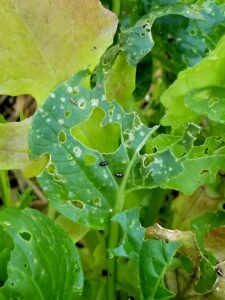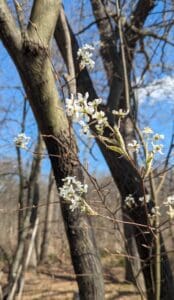
By Jennifer Fairfield
(Publisher’s note: Part One published yesterday.)
In the vegetable garden:
July is a great time to start new plants for late summer and fall harvest. You can direct seed Brussels sprouts, broccoli, cabbage, and cauliflower in the garden now. If you get bush beans planted now, you can be enjoying them all through September. Plant kale and beets at the end of this month, spinach and head lettuces in early August, and radishes and leaf lettuces in mid-August.
If you don’t have room in your garden for everything now, start head lettuce, cabbage, broccoli, and cauliflower indoors and plant them out after you have harvested your garlic and onions later this month or in early August.
Garlic is ready to harvest when about half of the leaves have turned yellow and withered. Harvest them when the soil is dry, using a trowel or fork to loosen the soil around them and carefully working the bulb out of the soil – be careful not to damage the bulb.
Keep the leaves and roots intact, and place the plants in a warm, airy place out of direct sun, to dry out for about a week. After that, cut the roots off to about ½ inch, and carefully brush off remaining soil. After about another week, cut off the stems and leaves. At this point, garlic should be stored in a cool, dry place until you’re ready to use it.
Onions are ready to harvest when the leaves have fallen over. Harvest them in the same way you do garlic – carefully loosen the soil around them to pull the bulbs out. Let them dry in a warm, dry, airy place, out of the sun, for about two to three weeks before cutting off the tops and roots. Store them in a cool, dry place.
July should be harvest time for many other crops as well. Spring crops, such as lettuce, spinach, and peas will mostly finish producing early this month, while summer crops, such as zucchini, cucumbers, and early tomatoes will generally just be getting started by the end of the month – though the way my tomatoes are going this year, I may be getting some a little earlier than usual.
Give your summer-producing plants a little fertilizer this month (known as side-dressing), just as they are really starting to produce. Side dressing provides fertilizer to your plants when they most need it – as they are beginning to flower and fruit. Harvest to Table offers more details about when and how much to side dress various vegetable plants.

Just like in flower gardens, July is garden pest time in vegetable gardens, too. Keeping them under control is essential because they not only eat your plants, but they can also carry diseases to your plants – both of these things lead to you not getting as much to enjoy. In my garden, the grasshoppers are just now starting to show up, while the slugs have been giving me a hard time for a while.
I also just saw my first potato beetle the other day – on an eggplant, which is a relative of potatoes. That one got squashed immediately – they are voracious eaters, and are very hard to control with pesticides, so I don’t want them getting established. Flea beetles have been an issue for the eggplants and other plants as well.
I’m also scouting my squash plants for squash vine borer moths and their eggs. I had a lot of damage last year because I didn’t do a good job of keeping them under control. I don’t want to let that happen again this year.
Mother Earth News has lots of great organic suggestions for dealing with all kinds of creatures that might have designs on your garden.
Weeding is most people’s least-favorite thing to do in the garden (though I do know a few people who find it calming). Since weeds compete for water and nutrition with the plants you want, it’s best to get them while they’re small. They are also easier to pull out before their roots are too established.
Keep an eye on the amount of rain you’re getting at your house. Don’t think that, just because we got some rain today, your gardens are all set. In general, your plants need about an inch of water every week, either from you or Mother Nature. When the temps are really high, and especially when accompanied by wind, a little more water is even better.
Don’t overdo it, but definitely make sure that your soil doesn’t totally dry out between watering, to be sure that your plants aren’t stressed. My veggie garden is in raised beds that drain very well, so tend to dry out easily and need to be watered more often than if they were in traditional rows in the ground. Your conditions are probably different from mine, so make sure to pay close attention to what’s going on in your garden.
A rain gauge is the best way to know how much rain you are getting, which helps you decide whether or not to water.
Keep up with the program of fungicide spraying that you started when you put your plants in the garden – you did remember to do that, right? If not, start now – it’s not too late. There are a lot of diseases that really get going as summer progresses, especially on tomatoes, cucumbers, and squash, which can kill your plants before you get to enjoy any of the fruits of your labor. You can help to stave off disease by spraying with organic fungicide on a regular basis.
If you’re seeing symptoms on your plants, and aren’t sure what you’re dealing with, you can find all kinds of great information from Cornell University’s Vegetable MD Online.

Trees & Shrubs
If you planted any trees or shrubs this spring (or really any time in the last couple of years), be sure to regularly water them. If we have an extended period of dry conditions, consider watering even older, established trees and shrubs to keep them from becoming stressed leading into winter.
Tree watering bags make your life much easier during extended dry periods. You only have to fill them up once or twice per week, and they slowly water your trees for you. Michigan State University’s Extension service published an article recently about the fact that trees are showing some stress due to the extremely dry and hot conditions experienced in our area in June, which included some tips to help your trees.
Do not apply fertilizer to trees or shrubs after the 4th of July, to avoid a flush of new growth that doesn’t have time to harden before winter.
Pruning too late in the season can also encourage new growth that will not have time to harden off before winter sets in, so finish pruning any trees and shrubs this month or early next.
Lawn:
When mowing this summer, leave your grass between 3 and 4 inches tall, and only cut off the top third of the blades at each mowing. Keeping your grass a little higher provides it with all kinds of benefits, including healthy roots, moisture retention, and weed suppression. Michigan State University’s extension service offers many more tips for having a healthy lawn in their “Smart Gardening” series.
When mowing and weed trimming, be careful not to get too close to your trees and shrubs. Damage done to them by lawn equipment is one of the most common causes of disease and death. Diseases enter through the wounds, infecting the entire tree, and eventually killing it.
For the Birds:
We are still dealing with the Avian Flu here in Michigan – as are many other states. While it seems not to be spreading as quickly in backyard flocks, some wild species of birds are being devastated by this disease. The Caspian Tern, a shore nesting seabird found on many islands in Lake Michigan, has been hit especially hard, according to a Michigan Radio report.
So, please keep your bird feeders cleaned out regularly. Use a 10% bleach solution weekly, then rinse well and let feeders dry out before refilling. Keep debris, such as sunflower shells, cleaned up around your feeders.
Also keep bird baths cleaned out. It’s always a good idea to dump out and refill feeders daily, to keep mosquitoes from laying eggs in the water, but also use a 10% bleach solution at least once per week to disinfect your bird baths. Just be sure to thoroughly rinse them before filling them back up.
Keep hummingbird feeders cleaned out and filled. Sugar water left out in the heat for a number of days can breed bacteria that is harmful to the beautiful birds visiting your feeders, so be sure to clean them out every two days when it’s really hot out, and no less than once per week during cooler spells.














